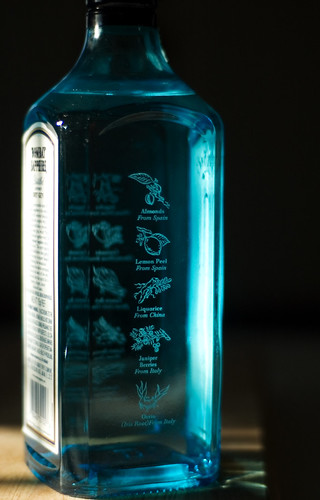

Playing around with the beautiful blue bottle.
Improves considerably large.
The martini is a cocktail made with gin and dry white vermouth.
While variations are legion, a standard modern martini is made by combining approximately two and a half ounces of gin and one half ounce of dry vermouth with ice in a cocktail shaker or mixing glass. The ingredients are chilled, either by stirring or shaking, then strained and served "straight up" (without ice) in a chilled cocktail glass, and garnished with either an olive or a twist (a strip of lemon peel, usually squeezed or twisted to express volatile citric oils onto the surface of the drink).
The martini was an established American cocktail at the beginning of the 20th century, but did not attain its pre-eminent status as the classic cocktail until later in the century. Perhaps paradoxically, Prohibition did a great deal to elevate the martini’s stature. Americans’ preferred tipple at that time — whiskey — requires skillful blending and long aging, whereas cheap but (marginally) drinkable "bathtub gin" is relatively easy to produce, so martinis were more readily available in the era of the speakeasy.
The Prohibition-era martini was quite "wet" by today’s standards. With the repeal of Prohibition, and the ready availability of quality gin, the drink became progressively dryer. (A "dry" martini is one with relatively little vermouth. One might say that a "very dry" martini is essentially a glass of cold gin, though the ice will contribute some water to the final drink.) This trend toward dryness eventually reached fetishistic extremes, and became the source of a considerable body of martini anecdotes, wit, and lore. One might prepare a martini by waving the cap of a vermouth bottle over the glass, or observing that "there was vermouth in the house once." Winston Churchill chose to forgo vermouth completely, and instead simply bowed in the direction of France, while General Patton suggested pointing the gin bottle in the general direction of Italy. Ernest Hemingway liked to order a "Montgomery", which was a martini mixed at a gin:vermouth ratio of 15:1 (these supposedly being the odds Field Marshall Montgomery wanted to have before going into battle). In a classic bit of stage business in the 1955 play Auntie Mame sophisticated pre-adolescent Patrick Dennis offers a martini, which he prepares by swilling a drop of vermouth in the glass, then tossing it out before filling the glass with gin. Similarly, in the 1958 movie Teacher’s Pet, Clark Gable mixes a martini by turning the bottle of vermouth upside-down before running the moistened cork around the rim of the glass and filling it with gin. Coating the cubes is a method of adding the flavor of vermouth by pouring the vermouth in separately then pouring it out before pouring in the gin. Also, atomizers similar to those used for perfume were sometimes used to dispense a token amount of vermouth.
Western culture has created a virtual mythology around the martini, in part because of the many legendary historical and fictional figures who favoured it. Churchill, F. Scott Fitzgerald, Hemingway, Cary Grant and James Bond among them. The dry martini is also sometimes called "The Silver Bullet" (rarely used today) because it "is clear, potent and never misses its mark".
The classic martini of yore was stirred, "so as not to bruise the gin." W. Somerset Maugham declared that "Martinis should always be stirred, not shaken, so that the molecules lie sensuously one on top of the other," while James Bond from the Ian Fleming novels ordered his "shaken, not stirred", a drink properly called a Bradford.
In the novel Casino Royale, Bond’s recipe is specified in more detail as made with three measures of gin (Gordon’s was Bond’s preference), one measure of vodka (Russian or Polish is preferred), and half a measure of Kina Lillet aperitif, shaken until ice-cold, and with a large, thin slice of lemon peel for garnish (properly called a "Vesper" after his love interest in the book). By the second Bond novel, Live and Let Die, Bond was drinking vodka martinis, a trend that continued when 007 moved to the screen in 1962.
The concept of "bruising the gin" as a result of shaking a martini is an oft-debated topic. A shaken martini is different from stirred for a few reasons. The shaking action breaks up the ice and adds more water, slightly weakening the drink but also altering the taste. Some would say the shaken martini has a "more rounded" taste. Others, usually citing hard-to-track-down scientific studies, say that shaking causes more of a certain class of molecules (aldehydes) to bond with oxygen, resulting in a "sharper" taste. Shaking also adds tiny air bubbles, which can lead to a cloudy drink instead of clear. Some martini devotees believe the vermouth is more evenly distributed by shaking, which can alter the flavor and texture of the beverage as well. In some places, a shaken martini is referred to as a "Martini James Bond".
Many variations exist on the standard martini described above.
A vodka martini (or vodkatini or kangaroo) is made the same way but with vodka instead of gin, and more often uses lemon rind as the garnish. This is the most common variation, and in fact is more popular than the original in most locations.
An in-and-out martini is a very dry gin martini prepared by pouring a small measure of vermouth into a shaker, shaking it to coat the ice, and then pouring out and disposing of any remaining vermouth. The standard amount of gin is then shaken over this vermouth-tinged ice and served normally. Former U.S. president Richard Nixon was said to favour this.
A perfect martini is technically one made with a mixture of dry and sweet vermouth, although in many bars the term is misused as a qualitative one.
A Churchill is made with dry gin, stirred, with an unopened bottle of vermouth waved above the shaker.
An apple martini (also sour apple martini or appletini) is a vodka martini with an apple flavoring such as apple schnapps, sometimes with apple, lemon or lime juice, and is often garnished with a slice of Granny Smith apple. Some people call this an "apple cosmopolitan".
A dirty martini has some of the brine (at least a teaspoon) from the olive jar added. (FDR was partial to a dirty martini.)
A naked martini is made without ice, but with the ingredients and glass chilled.
A sweet martini is made with sweet red vermouth, and may be garnished with a maraschino cherry instead of an olive.
A sake martini substitutes a dry, clear sake for the vermouth.
A Gibson is a standard dry martini that is garnished with cocktail onions instead of olives.
A tequila martini substitutes tequila for gin.
An akvavit martini substitutes akvavit for gin.
A gin salad is made like the ordinary martini but with three olives and two cocktail onions as garnish.
Information from Wikipedia.
Posted by ilmungo on 2005-12-21 19:19:05
Tagged: , bombay , sapphire , gin , alcohol , booze , bottle , blue , light , shining through , etched , ingredients , kitchen






